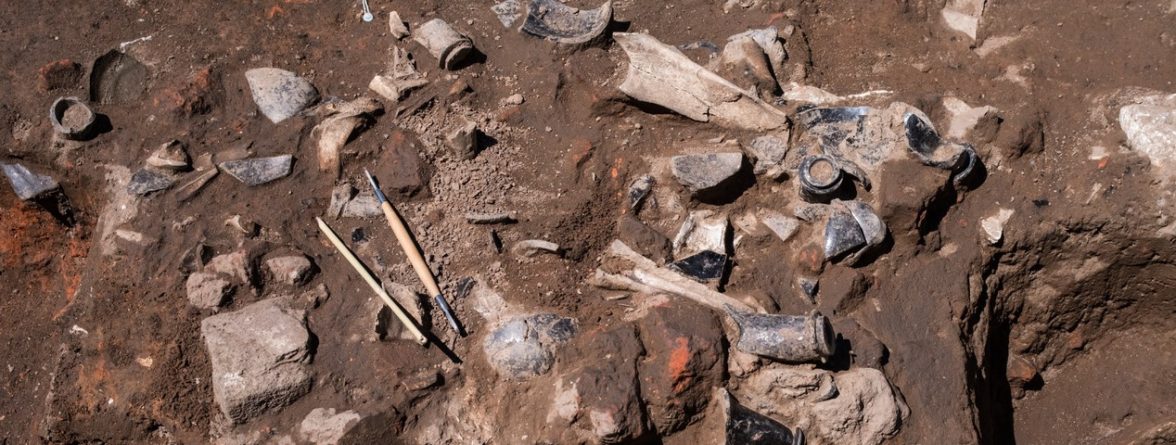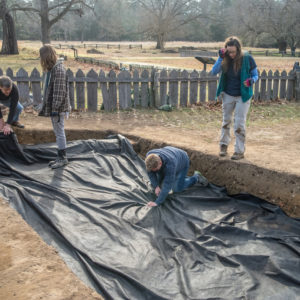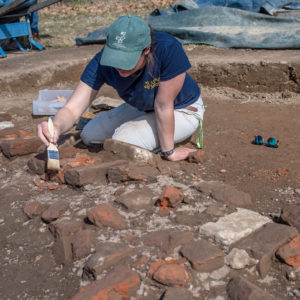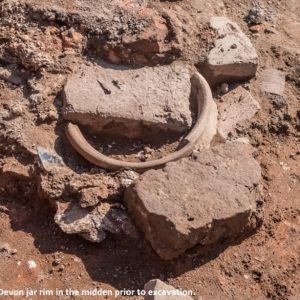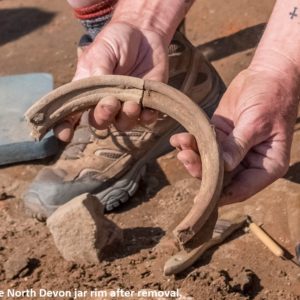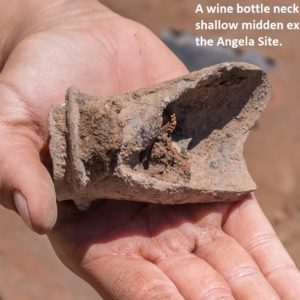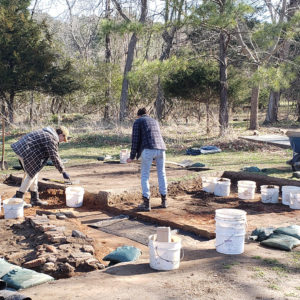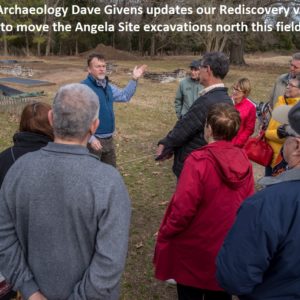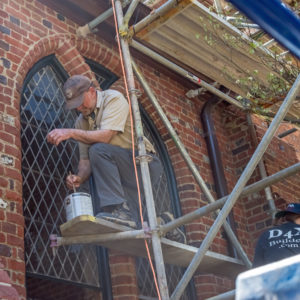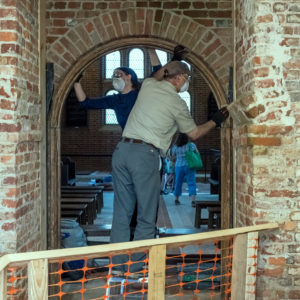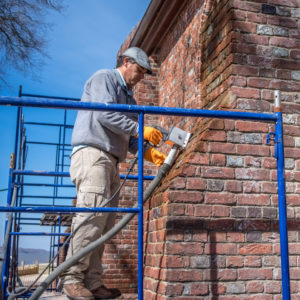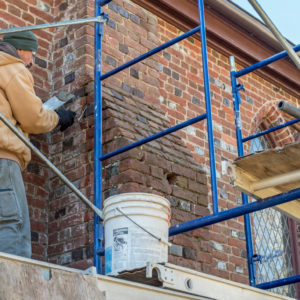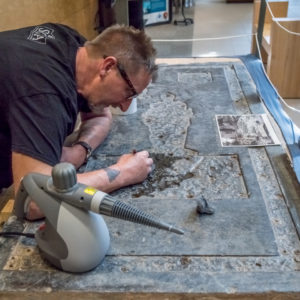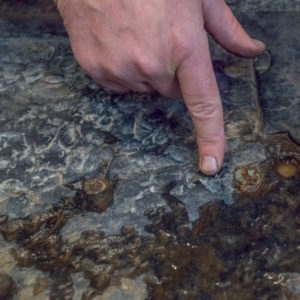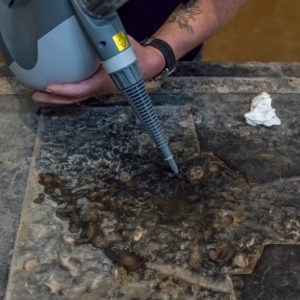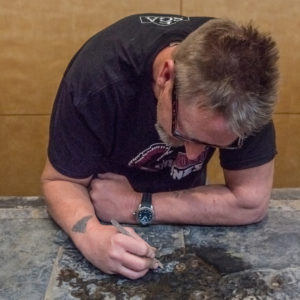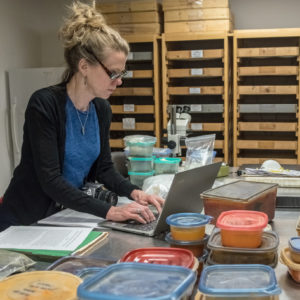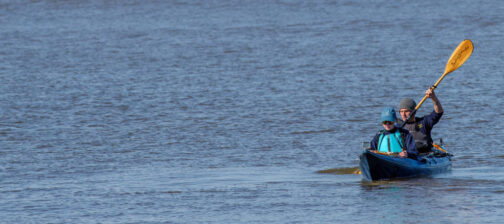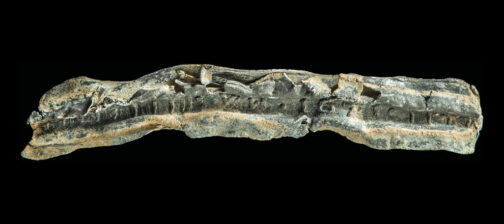As the weather improved, Jamestown Rediscovery archaeologists at the Angela Site backfilled areas opened in 2017 and investigated a couple of new areas to the north of the site. The first test unit uncovered a line of bricks that possibly underpinned an 18th-century Ambler family structure. Beneath the brick line was a 17th-century artifact-rich midden that intruded on part of a brick clamp or kiln.
Although shallow and small in size, the midden contained a heavy concentration of late 17th-century wine bottle fragments and the entire rim of a North Devon earthenware jar, suggesting that the midden relates to William Sherwood’s occupation. Numerous faunal bones were recovered, including the remains of cattle, pig, and sea turtle. The most unexpected discovery was an intact woman’s gold ring that is set with a faceted quartz crystal stone and embellished with white enamel. This delicate personal item may date as early as the late 1500s.
Expansion of the site to the east revealed more of the kiln, including many intact bricks. Comparison of these bricks to examples in extant foundations scattered around the site may help determine when the kiln was in use. Test trenches excavated by Civil Conservation Corps (CCC) in the 1930s were located, and the team intends test one in the future.
Director of Collections and Conservation Michael Lavin worked with archaeologists to complete tasks in advance of the reconstruction of the church floor and the installation of new exhibits. Two tests into the 1617 church’s south foundation wall were conducted so that a glass portal above the installation can be installed. This will allow visitors to see the archaeological remains of the foundation. Also, because of the discovery in the tower of the west wall of the 1617 church, the team and Steman Pease Architecture architects and engineers redesigned the entire floor plan for interpretation to the public.
Concurrent with the archaeological, architectural, and engineering work in the church, renovations and restoration on the Memorial Church exterior began in March. Led by Mike Adams, Preservation Virginia’s restoration team began to repair and paint door and window frames and to replace broken glass panes. Master brick mason Ray Canetti and his team constructed scaffolding around the church and began the repair and replacement of mortar joints and missing mortar and to clean the brickwork. These massive undertakings will likely continue for months.
During February and March, visitors watched as Senior Conservator Dan Gamble finished conserving the Knight’s Tombstone in the Historic Jamestowne Visitor’s Center lobby. He removed a thin, water-based lacquer applied decades ago to enhance its appearance. Gamble used steam heat and acetone to dissolve the lacquer, then carefully removed it using a scalpel. The most challenging and time-consuming effort was the removal of lacquer in the channels that once held engraved brasses. In a few weeks, the stone will return to the 1906 Memorial Church for placement in the new church floor.
As part of a grant to evaluate the status of archaeological collections in the Jamestown area, archaeobotanist Justine McKnight began an assessment of botanical and geological samples in Rediscovery’s archaeological collection in March. McKnight is experienced in the identification of botanical material from both pre-colonial and colonial sites throughout the Mid-Atlantic, and has worked with Rediscovery previously. With the assistance of Associate Curator Leah Stricker, who is also an archaeobotanist, a number of organic artifacts in the collection were identified. They determined that the collection contains five types of wood; 22 species of seeds, including tobacco, corn, wheat, and beans; three species of nuts; and numerous other organics such as leaves, squash, fruit stones, and grass. They reorganized the collection, rehoused many items, created new inventories, and prioritized the assemblage for future research. In the hope that funds are forthcoming, processing, analysis, and research of this significant environmental collection will move forward in the future.
This month’s YouTube video features Senior Curator Merry Outlaw discussing a Roman oil lamp found in James Fort. Please stay tuned for more exciting news about future archaeological discoveries and research at Jamestown Rediscovery!
related images
- Archaeologists at the Angela Site lay down filter cloth in test units to prepare to backfill the site
- Angie Tomasura cleans brickwork at the Angela Site which might relate to a building on the Ambler property during the mid 18th century
- Delaney Hunter and Angie Tomasura excavate artifacts from a midden that sealed the brick kiln found at the Angela Site
- North Devon jar rim in the midden prior to excavation
- North Devon jar rim after removal
- A wine bottle neck found in a shallow midden excavated at the Angela Site
- Archaeologists at the Angela Site open more units to the east of the brick line to expose more of the brick kiln
- Lee McBee exposes a row of intact bricks related to a brick kiln at the Angela Site
- Director of Archaeology Dave Givens updates our Rediscovery volunteers about plans to move the Angela Site excavations north this field season.
- Scaffolding surrounds the Memorial Church as preservationists work to restore the structure ahead of the new exhibit installation inside.
- Spencer Siebeck, from Preservation Virginia’s Restoration crew, works around one of the windows in the 1906 Memorial Church
- Preservation Virginia Craftsman Mike Adams paints the frames around the Memorial Church windows
- Spencer Siebeck and Mike Adams restore the door frame for the church’s west entrance
- Cleaning up the concrete joints on the Memorial Church brickwork
- Restoration of the Memorial Church brickwork
- Dan Gamble completes the conservation of the Knight’s Tombstone by removing a water-based glue someone in past had used to polish the stone.
- Gamble points to crevices in the stone from which he is trying to remove the old glue. This area originally held the Tomb’s inscription.
- Gamble uses steam heat and acetone to dissolve the glue on the stone
- Gamble uses a scalpel to gently lift away the glue
- Leah Stricker and Justine McKnight discuss Jamestown’s botanical samples and future research strategies for the collection
- Leah Stricker and Justine McKnight examine botanical samples from the Jamestown collection
- Justine McKnight accessing some of the botanical samples in Jamestown’s collection


